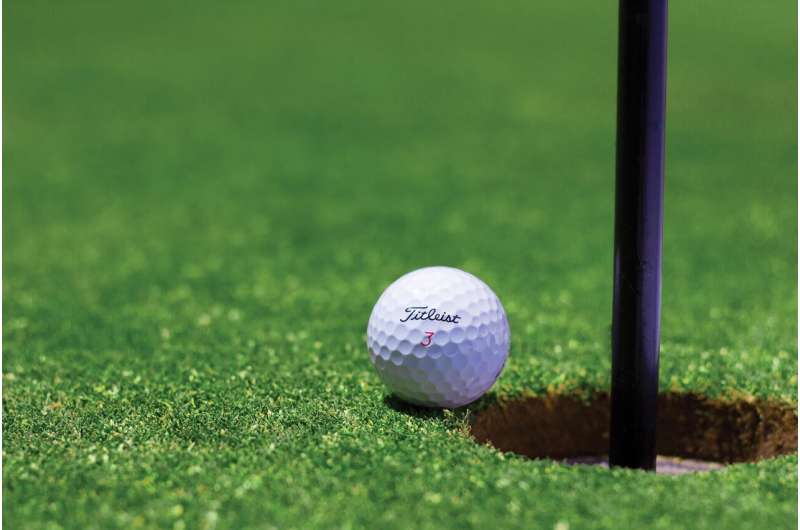Science
Understanding the Physics Behind Golf’s ‘Lip Out’ Phenomenon

New research from the University of Bristol delves into the physics behind the frustrating phenomenon known as the “lip out” in golf. This occurrence happens when a putt appears to be on target, only to roll up to the edge of the hole and bounce back onto the green. The study, led by Emeritus Professor John Hogan from the School of Engineering Mathematics and Technology, focuses on the mechanical principles that govern this common mishap.
Defining the Lip Out
The lip out can affect both professional athletes and amateur players. As the ball approaches the hole, it can strike the rim (or lip) and fail to drop in, leading to disappointment. Professor Hogan refers to these moments as involving “golf balls of death,” likening their behavior to the dangerous stunts performed by motorcycle riders in the “wall of death.”
In his research published in Royal Society Open Science, Professor Hogan identifies two distinct types of lip outs: the rim lip out and the hole lip out. The rim lip out occurs when the center of mass of the golf ball never falls below the level of the green, while the hole lip out happens under specific conditions, resulting in the ball entering the hole but subsequently returning to the rim.
The Mechanics at Play
At the core of this phenomenon lies a concept known as “degenerate saddle equilibria,” which refers to the delicate balance when a golf ball teeters on the edge of the hole. According to Professor Hogan, the rim lip out sees the ball rotating around the hole at a fixed angle and speed. A minor perturbation—such as a gust of wind or a grain of sand—can determine whether it sinks into the hole or rolls back onto the green.
The hole lip out, on the other hand, occurs less frequently and requires specific conditions. Here, the ball falls into the hole and undergoes a pendulum-like motion. This motion converts potential energy into spin, allowing it to return to the rim provided it does not make contact with the bottom of the hole.
So, how can golfers improve their chances of avoiding the lip out? Professor Hogan suggests that players should aim as close to the center of the hole as possible and approach the rim with minimal speed. This strategy allows just enough momentum to nudge the ball into the hole without sending it back onto the green.
Professor Hogan’s work emphasizes the application of mechanics, a field that includes the study of motion influenced by forces. This approach is not new; Sir Isaac Newton’s Laws of Motion serve as foundational principles in both planetary science and sports dynamics. Hogan’s research builds on his previous studies in the physics of skateboarding and basketball, showcasing how scientific principles can enhance understanding in various sports contexts.
The findings provide golfers with a deeper insight into the forces at play during a putt, potentially changing how they approach their game. As the study illustrates, even a small adjustment in technique can lead to a significantly different outcome on the green.
For more detailed insights, refer to the study published in Royal Society Open Science in March 2025, which can be accessed through their official site.
-

 Science3 weeks ago
Science3 weeks agoInterstellar Object 3I/ATLAS Emits Unique Metal Alloy, Says Scientist
-

 Politics3 weeks ago
Politics3 weeks agoAfghan Refugee Detained by ICE After Asylum Hearing in New York
-

 Business3 weeks ago
Business3 weeks agoIconic Sand Dollar Social Club Listed for $3 Million in Folly Beach
-

 Health3 weeks ago
Health3 weeks agoPeptilogics Secures $78 Million to Combat Prosthetic Joint Infections
-

 Science3 weeks ago
Science3 weeks agoResearchers Achieve Fastest Genome Sequencing in Under Four Hours
-

 Lifestyle3 weeks ago
Lifestyle3 weeks agoJump for Good: San Clemente Pier Fundraiser Allows Legal Leaps
-

 Science3 weeks ago
Science3 weeks agoMars Observed: Detailed Imaging Reveals Dust Avalanche Dynamics
-

 Health3 weeks ago
Health3 weeks agoResearcher Uncovers Zika Virus Pathway to Placenta Using Nanotubes
-

 World3 weeks ago
World3 weeks agoUS Passport Ranks Drop Out of Top 10 for First Time Ever
-

 Entertainment3 weeks ago
Entertainment3 weeks agoJennifer Lopez Addresses A-Rod Split in Candid Interview
-

 Business3 weeks ago
Business3 weeks agoSan Jose High-Rise Faces Foreclosure Over $182.5 Million Loan
-

 Top Stories3 weeks ago
Top Stories3 weeks agoChicago Symphony Orchestra Dazzles with Berlioz Under Mäkelä








